I didn’t know what I expected when I set out on the Tuscan Camino – verdant hills, belly-filling pasta, glorious sunshine, perhaps, you know, all the things you think of when you imagine exploring one of the culturally rich regions on earth.
That’s what I’m pondering as I’m sitting with friends with the lightning flashing and the rain beating down, tucked away in a café in Gambassi Terme.
What I didn’t expect to find, stormy weather aside, was the elusive ‘off switch.’ It’s a different kind of break than comes from sitting on a beach, checking social media, and scouting the nightlife scene.
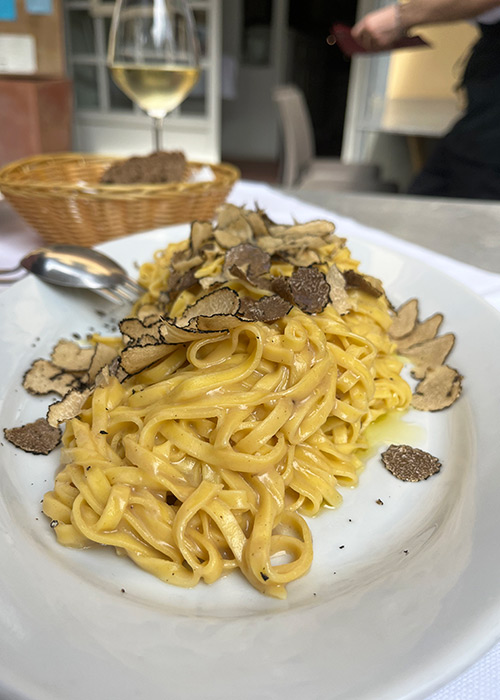
Here we were practically inhaling our pizza with the sound of our laughter drowning out the thunder thrashing about outside, making conversation with our fellow ‘pilgrims’, weighing each other up, asking who was going to make a run for it first and crucially with no phones in sight.
Then the next morning, blissful sunshine as if the whole thing had been a dream. The Italian leg of the Via Francigena stretches from the Great St. Bernard Pass on the border with Switzerland and runs right to Rome.
Day one: San Miniato
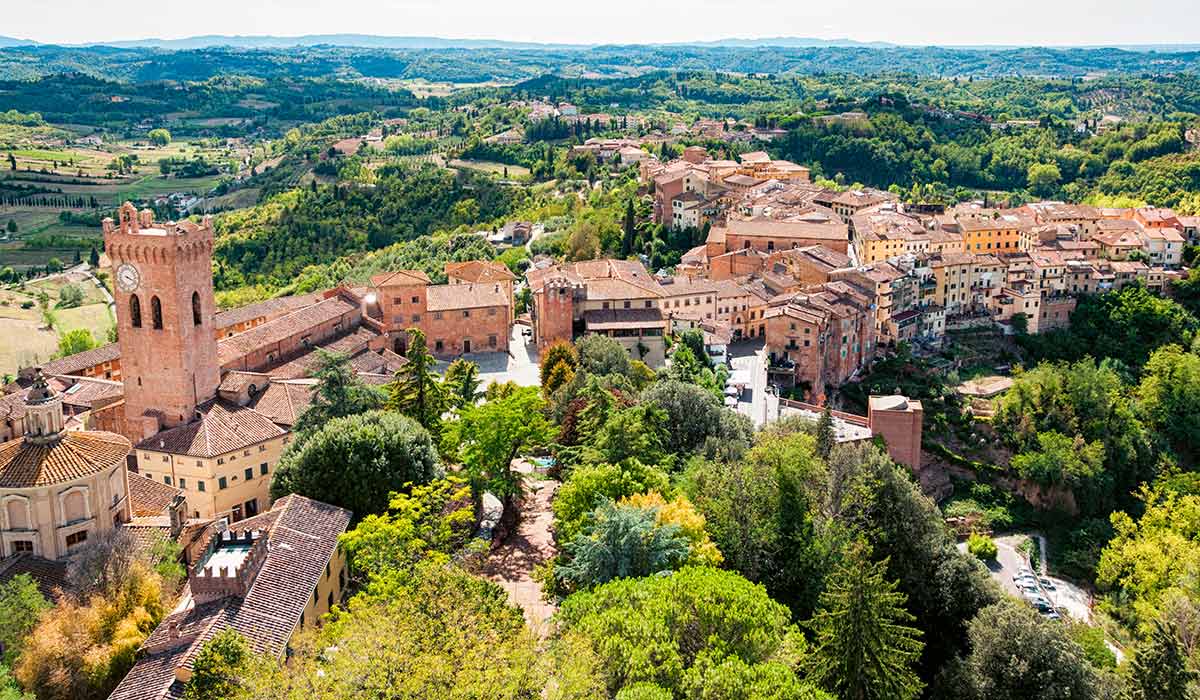
Our journey began two days earlier in San Miniato. Landing into this dreamy little town at lunchtime on a Sunday is like travelling back in time.
There is seemingly not a soul in sight, it almost feels as if we’re the first visitors to set eyes on the place in centuries, and yet discarded cups on a window ledge hinted at a buzzing local social scene.
Venturing further into the Centro Storico brought us into contact with the two remaining open restaurants just as they were about to pack up for the afternoon, and we had good reason for feverishly eyeing up a table. This is truffle country (there’s even a festival in November), and the anticipation of the first tangy taste had been calling ever since we landed at Pisa airport. As we waited, the conversation turned to the man sitting outside directing all of the action in the restaurant. Was he a manager or the owner?
Either way, his job appeared to be sitting in the sunshine, reading the paper and keeping an occasional eye on the proceedings. Not a bad life, we mused.
San Miniato lies between Florence and Pisa and also on the Lucca-Siena axis.

Sightseeing here is a leisurely affair, the main ones being the Duomo (cathedral), which began life as a Romanesque building that over the centuries has acquired both Gothic and Renaissance detailing and the Palazzo Comunale, which dates to the 14th Century and still serves as the city’s town hall. The Church of the Santissimo Crocifisso offers pretty photo ops from all sides. As the sun sinks, the shutters fly up on the shop fronts, and the lazy peacefulness is shattered by the hustle and bustle of modern life. After several hours spent sipping wine and swapping trekking stories, it was time to hit the hay.
I’d been forewarned to expect modest lodgings while trekking the Camino, but not that I’d be spending the night in a reimagined tenth-century bastion with striking views and which houses over a hundred works of art.
It’s said that in 1533, Michelangelo travelled to San Miniato to confront Pope Clement about the proposed design for the altar at the Sistine Chapel, and it’s mind-boggling to think that centuries later, right down to the day, I was sleeping in a building (now Hotel Miravalle) that existed then.

Eat: Osteria L’Upupa – Excellent selection of pasta dishes, including truffle options.
Stay: Hotel Miravelle: -Historic hotel with an impressive art collection and striking views of San Miniato and the surrounding countryside.
Day Two: ‘And we’re off’… to Gambassi Terme (24km)

The next morning, not quite so early as we’d planned and as it turns out not that bright either, we set off on our big adventure. Half an hour later, and we’re back where we started, welcome to life on the road, but even if you do take a wrong turn here and there, the scenic views make up for any extra steps added to the itinerary.
After finally finding our bearings, it wasn’t long until the countryside melted away into green on all sides. Day one was the longest day of our trip with Camino Ways and stretched to 24km.
A confession: I’d built this leg of the journey up in my head to be a breath-stealing hike for my as-of-yet untested legs, but I barely noticed the subtle peaks and climbs. Instead, I was too busy chatting to be concerned about huffing and puffing up hills, and before I knew it, we’d reached the first Road to Rome sign.
It’s funny to think how many other travellers have stopped there, had taken the same photo, each with their own reasons for hiking the Via Francigena.

Tired feet and the first drips of rain quietened the conversation as Gambassi Terme came into view, but not for long.
Before even finding our lodgings, the quest for sustenance leads us to a covered bar area in one of the picturesque town squares where a heated debate was rumbling on over a game of cards being played by a group of gentlemen of a certain age.
This was people watching at its best. Did they meet every day? We asked ourselves. Our conversation flowed as fast as the drinks, and it was almost dark before we'd finally mustered the energy to find our lodgings just as the storm began gathering pace. Our bed for the evening was a Tuscan-style villa with a homey feel and a gorgeous garden.
There was just time for a quick scout about the picturesque streets before we set off the next morning, but Gambassi Terme is known for its healing thermal springs for those who want to linger longer.

Eat: Pontormo Caffe- Mouthwatering pizza in a homely atmosphere.
Stay: Villa Della Certosa - a friendly welcome and pretty garden space to enjoy on sunnier days.
Day 3: Raising a glass to San Gimignano (14km)

Lush vineyards pointed the way to the most scenic leg of our Camino trip - the route to the UNESCO protected San Gimignano.
With the temperatures soaring, there was an irresistible pull to indulge in a cool glass of Vernaccia di San Gimignano.
The local white wine was the first Italian wine to be awarded the DOC standard classification in the 1960s and has since been upgraded to the DOCG, the highest classification for Italian wines.
It can’t be topped on a sunny day whilst drinking in the distant city views but the region is best known for its Chianti which has been produced in Tuscany unofficially since the 14th century and originally as a white wine.
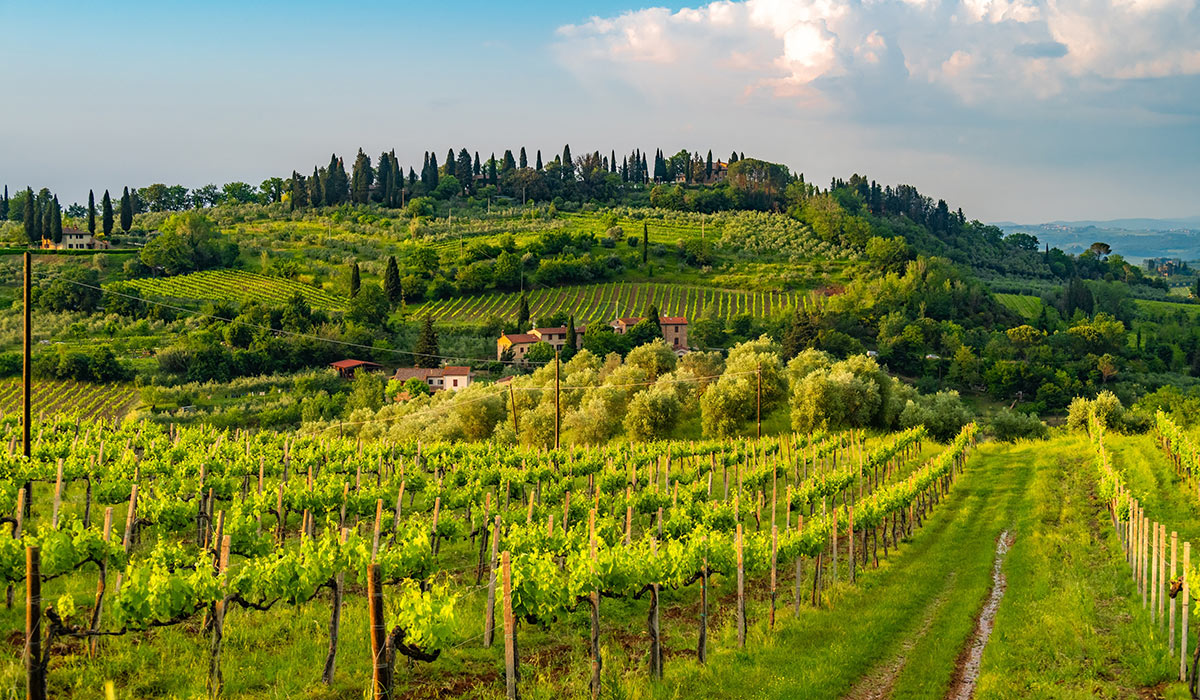
By now, my hiking legs had fully kicked in, but while this stretch of the Via Frangenica is less of a struggle, it begs to be explored at a leisurely pace.
This is Tuscany at its bucolic best, and that first heady glimpse of San Gimignano’s towering gates will catch in your throat.
The entryway into the city is lined with shops selling everything from cured meats, to pecorino cheese, to leather goods and, of course, pasta of all shapes and sizes.
Saunter further along, and a Dante impersonator belts out lines from The Divine Comedy. The supreme poet travelled to the city in 1300 AD on a diplomatic mission, and his presence is still felt in every nook and cranny of the city.
San Gimignano swells with overwhelming levels of day trippers at certain times making early morning and evening best for exploring the sites which include the San Gimignano Torre Grossa Tower, and the Musei Cicvici.

In between, base yourself in one of the many outdoor eateries and people-watch to your heart's content.
That night was spent in the comfortable surroundings of Hotel Graziano just outside the city walls. Curiously the best view of the city comes as you leave and looking back will want to make you want to extend your stay.
Eat: La Marronaia – gorgeous winery located just outside San Gimignano that offers tastings and cooking classes.
Stay: Hotel Da Graziano – comfortable lodgings, a stone’s throw away from the city gates.
Day 4: Colle Val D’Elsa (13km)

‘I’m waking for peace,’ Bernadette from France informs me as we trample through brambles and farmlands. She and her friends hike each year for a worthy cause, and it’s hard to think of anything more appropriate right now.
Hiking the Via Francigena, you encounter all shades of human life, and adding a backstory to each of the characters we met along the way became a daily pastime.
On to the next stop. Sleepy Colle Val D’Elsa deserves more than just a pitstop even if just to catch your breath and enjoy a tasty meal. The lesser visited city offers much of the old-world charm of San Gimignano minus the crowds.

Start at the ‘Volterrana Gate’, which dates to 1479 and wind your way around to the Palazzo Campana, stopping for an obligatory picture under the archway. The city was built on industry and is known in particular for its crystal making (there’s a museum) and you’ll find gorgeous glassware in the local shops, if you have space in your backpack.
Come sunset, grab a spot a L’Angolo di Sapia Osteria for a sundowner in what might be the prettiest viewpoint in the city.
Eat- Gimmy Gio’s- serves up hearty Italian cuisine with a side order of people watching.
Sleep: La Vecchia Cartiera– Centrally located hotel with an impressive breakfast.
Day 5: Monteriggioni (14km)
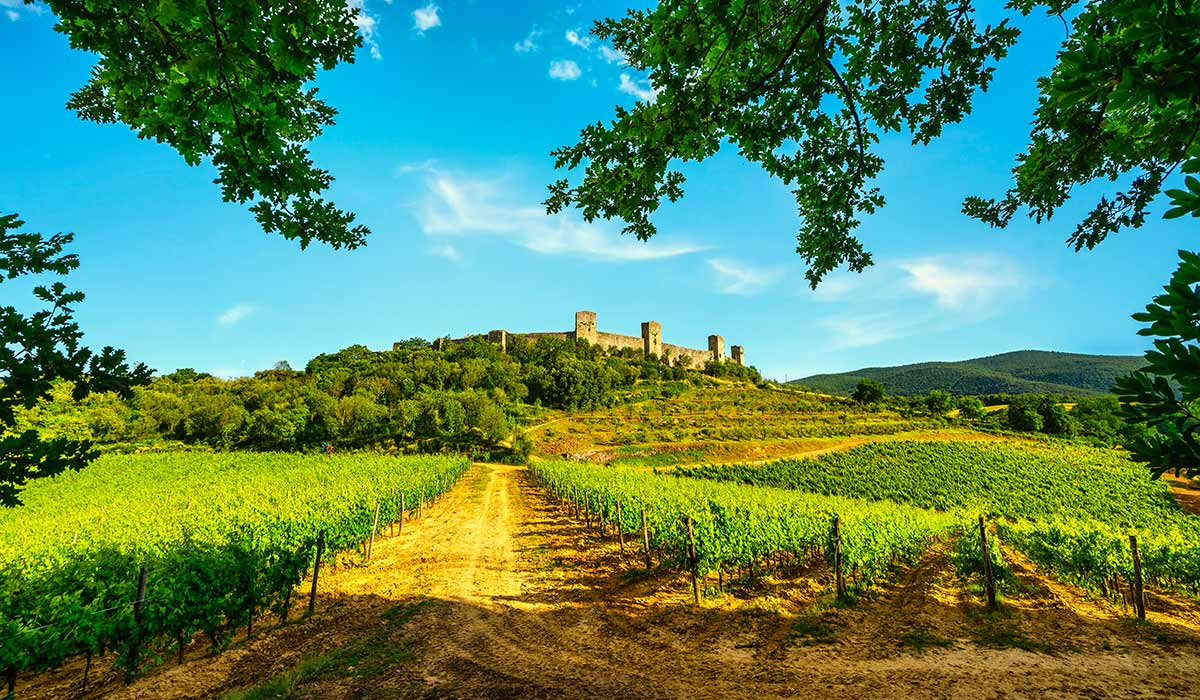
There are two routes for leaving Colle Val D’Elsa, the straightforward route and the scenic one, which takes you across nerve-jangling bridges and lush wooded areas. It’s worth taking the latter even if it adds to the day’s hike.
As you leave town, the route winds deeper and deeper into rural bliss across wide open vineyards and into forested areas punctuated by atmospheric strongholds.
My earlier cockiness dissipated into aching limbs that were struggling to keep pace on the hottest day of our Camino. The near vertical climb (at one point I’m almost on all fours) to hilly Monteriggioni definitely winds me but the view from the top makes up for it in spades. There’s not much to do here except savour the surrounding views, best enjoyed from the city walls, browse the smattering of shops, and of course, people watch.
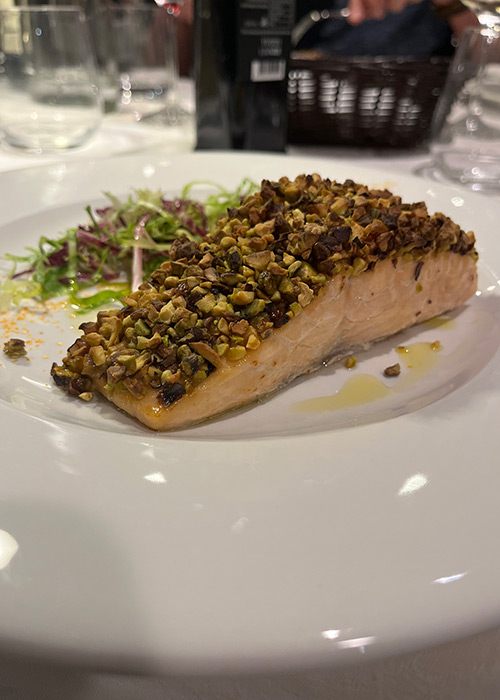
It was our turn to be watched and pondered about later that day as the Australian woman at the next table at dinner leaned over and said: "I have to ask…. How do you know each other?" As we encouraged her to guess, she tentatively surmised that we were on a family holiday and that 'the dad' (my friend) and his 'glamorous ex-wife and my stepmum' (also my friend) had come together for the sake of 'the child' (me) much to their amused outrage and that's a story I'll be dining out on for years to come.
The food that night at Il Piccolo Castello was among the best on the trip - try the baked salmon in pistachio crust.
Eat: The restaurant at Il Piccolo Castello Monteriggioni - serves tempting local specialities.
Sleep: Il piccolo Castello Monteriggioni – Comfortable, four-star hotel with traditional décor and a bath!
Day 6 Sienna (21km)

The finale hike tests worn out limbs, and in particular the last stretch, and it’s a relief when Siena comes into view. Peeling off our muddy layers, we go from pilgrims to tourists. Our group opted to book an extra night, but the luxury of lingering a little longer in bed is tinged with sadness at not setting out the road that had become routine.
Still Siena’s charms don’t disappoint including, of course, the Cathedral that dominates the city skyline, get there early and prepare to queue regardless. Inside you’ll find yourself jockeying for space but even that’s not enough to take the shine off a visit.
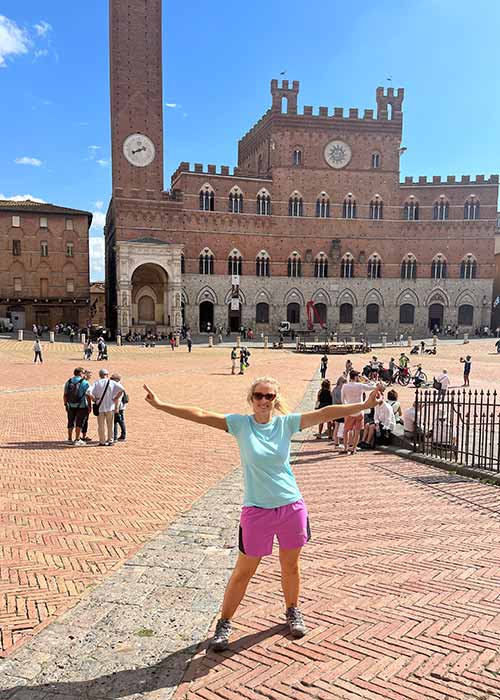
Perching up in the world-famous, UNESCO-rated Piazza del Campo is another obligatory stop off and if your worn-out limbs permit, climb to the top of The Torre del Mangia for spectacular views of the city. There are also any number of excursions and shows to fill your time.
Equally, after five days on the road, relish, as we did in the indulgent thrill of pottering around the shops, filling up on pasta, people watching and switching off. You’ve earned it.
Eat: Osteria Sotto Le Logge – historic spot with plentiful portions and a great atmosphere.
Sleep: Il Chiostro del Carmine – Former monastery with cloister-style rooms a short walk from the cathedral.
Need to know
Camino Ways offers packages from San Miniato to Siena start at €1,045 for solo traveller and €1,700 per couple for six nights bed and breakfast with dinner and luggage transfers. See more at caminoways.com.
Aer Lingus flies direct from Dublin to Pisa with three flights per week in June, and four in July, August and September. See more at aerlingus.com









